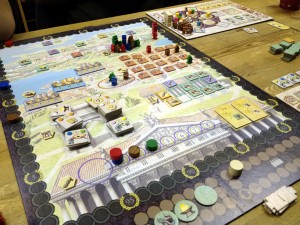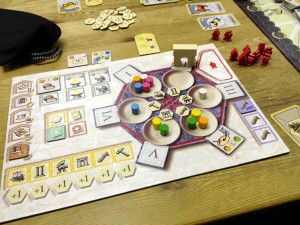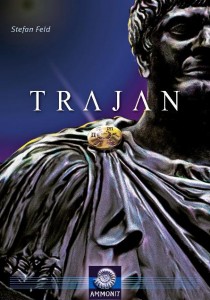Review: Trajan
Posted by James (admin) on November 1st, 2011
 Initially, Trajan looks like a complicated game but it isn’t really – it just offers choices all built around a clever, but not over-powering, central mechanic.
Initially, Trajan looks like a complicated game but it isn’t really – it just offers choices all built around a clever, but not over-powering, central mechanic.
GAMEPLAY
Players are trying to score victory points (VPs) by fulfilling the people’s demands and furthering Roman power. Each turn, a player gets to perform one of the 6 actions: building, shipping, forum, senate, military, and Trajan. So, the overview is simple, but the mechanics and choices are what really deliver a great game.
Determining the Action to Take
On their turn, players can not simply choose any action they wish. Instead, each player’s player board shows 6 pots each relating to one specific action. In these pots are 12 coloured pieces (6 coloured pairs). On their turn, a player takes all of the pieces from any one pot and distributes them one at a time into the next pots going clockwise from where they took the pieces from. (This distribution game mechanic is widely known from the game Mancala – a traditional game in Africa and some parts of Asia dating back as far as 600 AD). The player can choose which colour is dropped off in which pot (I’ll explain why that’s relevant shortly). The pot where the final piece is placed is called the ‘target pot’ and it is the action associated with that target pot that the player gets to perform.
Therefore, the player needs to manipulate their coloured pieces so they can perform the actions they want to. If you can’t immediately trigger the action you want, you need to work out how to manipulate the pieces so you can (and, hopefully, either work out how to trigger actions useful to you whilst doing so, or work out how to best use the actions your movements will cause).
But why the different colour pieces? Well, next to some of the pots are Trajan tiles which each show 2 colours as well as some other benefits. If the target pot contains coloured pieces that match the colours on the Trajan tile next to it, the player completes the tile and gets the VPs and any special action shown on it too.
Choices Within Each Action
The 6 actions are relatively simple but most offer several options within them. For example, when shipping you can either take 2 face-down commodity cards, or 1 of the 2 face-up commodity cards, or lay commodity cards down from your hand (which can earn VPs at game end), or spend commodity cards to earn immediate VPs. Another example, is the military action where you can either gain a legionnaire, move your leader (potentially gaining a resource/extra action tile), move a legionnaire to your leader’s location (potentially gaining VPs).
Not all actions have options but all require some level of decision-making to be made as you need to choose the benefit from that action that will combine well with your other choices to maximise your VPs. This may sound like it’s complicated but they’re not and they add that extra bit of gameplay depth but without causing long delays or confusion.

The mancala is the main part of the player's board with other locations to store resource tiles, building tiles, completed Trajan tiles, etc. Note if I move the white piece from pot III, I would place it in pot IV gaining the senate action as well as completing the Trajan tile on IV too.
Player Interaction and the People’s Demands
There are lots of ways to score VPs but other players can still get in your way. Player interaction is interesting as it takes the form of various races to secure items such as tiles in the forum and military areas, tiles in the building area, votes from several areas to win bonus tiles in the senate, and so on.
One very important race is that for resources as, each quarter of the game, the people make demands and players suffer minus VPs if they can’t fulfil these. Each time a player takes their turn, they move the time marker along its circuit a number of steps equal to how many pieces that were moved on the mancala. Each circuit of the time track is a game round and 4 rounds make a quarter of the game.
After each of the first 3 rounds in a quarter, 1 required resource is revealed so what’s being demanded isn’t a total surprise. On the 4th game round of a quarter, the players must pay the demand (no new demand is added that round). The negative VPs can be quite serious so players try to get the resources required which creates additional short-term goals and (entertainingly) there are often not enough resources to go around. Resource tiles get used up when fulfilling demand, but some Trajan tiles give you a permanent resource – these were very popular in our game.
Game End
There are some extra VPs to be earned at the game end too, e.g. sets of the same building. Plus, each player starts the game with a bonus tile which shows how that player can earn extra VPs at game end. So, each player even has their own slightly different perspective to the game and players can potentially gain more of these bonus tiles during the game too. Our game of 4 experienced gamers (all playing Trajan for the first time) was very close.
 OPINION
OPINION
Trajan may appear complicated when first looking at it but it’s actually relatively simple. The options within, or small extra facet to, each element adds extra depth which combine to deliver a satisfying and cohesive experience. Most turns are simple and the game moves at a good pace with little downtime.
I really like that the mancala system delivers a great game-driving mechanic but doesn’t over-power the rest of the game at all. I found I thought more about what actions I wanted to take and how I could make the mancala work for me, but there were also times when I had to figure out what I could do with the actions that my current mancala position would allow me to.
The part of Trajan I enjoyed most though was that it consisted of multiple medium-term plans – you could plan some goals and try and make them happen but could change them and react to events at any time. Most games are either tactical turn-by-turn planning, or having a single long-term plan to execute throughout the whole game; whereas, Trajan allows you to make lots of short- to medium-term plans as you go (but creating good combinations of these will maximise your VPs). This felt very different to most other games to me and I really liked the strategic agility so I could plan and execute but without the fear of indelibly messing up early on.
I didn’t think too far ahead with mancala movement – probably 3 turns at most – but I didn’t feel I really needed to. Also, I didn’t stress too much about which colour piece was placed in which pot apart from obvious requirements to complete Trajan tiles. This could have been a source for analysis paralysis and was nice to see it didn’t need to be. Also, I liked how players can never be completely sure how long a round will last – you just need to act as quickly as you can.
So, Trajan delivered a game that I felt was challenging, interesting and contained meaningful decisions. I felt I needed to have strategies but I was able to recover from problems, but without being so forgiving choices weren’t important.
During Spiel, I was asked several times what my favourite game of the show was. This year I’ve struggled slightly to pick the games that were clearly above the rest (Last Will was one that did stand out for me). However, Trajan is definitely in the category of my favourite games of Spiel 2011. I was interested in Trajan primarily because I have enjoyed other games by Stefan Feld. So, I picked up a copy as soon as Spiel opened because there was no pre-order system. Having now played the game, I’m extremely glad that I did.
James.
[Played with 4 players]


November 6th, 2011 at 4:24 pm
Great review.
December 27th, 2012 at 12:47 pm
Really good review. You manage to succinctly explain a game that initially looks overwhelming and intimidating, but actually has a beautiful clarity and simplicity once under way. If I hadn’t already bought the game I would now on the strength of your review 🙂